History
Origins
These early Tone Benders were built with a three-transistor fuzz circuit, based on Gibson’s 1962 Maestro Fuzz-Tone. The Maestro Fuzz-Tone was an American product, and was predominantly sold in the United States, where the majority of surviving examples resurface nowadays. Nevertheless, the Gibson fuzz boxes found their way into the hands of several notable British guitarists, and the circulation of those primitive early American fuzz boxes around the London music scene can at least be partially explained by the fact that the Selmer shop on Charing Cross Road was importing them.1
During the early 1960s, Gary Hurst worked as a repairman and engineer for Vox. Hurst recalled initially commuting from London to the Jennings “laboratories” in Dartford, where he worked briefly with Dick Denney, and that, slightly later, Tom Jennings set him up with his own dedicated space close to the (then-)Jennings shop at 100 Charing Cross Road. The exact dates of these events are unclear, but at some point Hurst stopped working for Vox, and spent several months working on Organs for Elka in Italy.2 In one version of events, as recalled by Gary, it was confirmed that he worked in London’s West End in 1964.3 By 1965, Gary was back in London, and was working out of the back of Larry Macari’s new Musical Exchange shop on 22 Denmark Street. This is where and when the Tone Bender was born.
This sequence of events is rather complicated, and took place at various different locations that were all mere minutes away from each other. The map below shows how close Macari’s Musical Exchange, Tom Jennings’ Vox shop, and the location of Gary Hurst’s workshop all were to one another.
Mistaken identities
Over the years, Gary Hurst has consistently recalled the story about a day at work, when he was approached by an eminent session musician, dissatisfied with his Maestro Fuzz-Tone, and who asked Gary whether he could improve the pedal. Gary agreed, but ended up supplying his customer with a brand new fuzz box instead of their Fuzz-Tone, which to this day, Gary still owns.4
These events certainly took place before 1965, because Gary Hurst was reported to have begun developing his fuzz box as early as in mid-1964,5, and that development was put on hold until April of the following year, after Hurst had returned to London following the aforementioned period of working for Elka in Italy.6 Gary recalled having an awareness of fuzz guitar effects prior to his encounter with the session guitarist & their Maestro Fuzz-Tone, making reference to a P.J. Proby recording.7
The identity of the session guitarist who approached Gary Hurst with a Maestro Fuzz-Tone is a contentious subject. Hurst has long maintained that it was Vic Flick (famously responsible for the lead guitar motif on ‘James Bond Theme’) who enquired about having his Fuzz-Tone modified, and who was subsequently supplied with the very first Tone Bender. Vic Flick, however, has on several occasions in recent years, denied any involvement or association with Gary Hurst and the Tone Bender.8 Flick recalled visiting Macari’s Musical Exchange during the 1960s, and speaking with somebody there about how his Maestro Fuzz-Tone “didn’t cut it”, but explicitly maintained his position that he had no connection with Gary Hurst. Flick also condemned Music Ground (a manufacturer of modern fuzz boxes under the ‘JMI’ and ‘British Pedal Company’ brands) for using his name in their advertising. Vic Flick went as far to point out that he still owned his original Maestro Fuzz-Tone, which is pictured in his autobiography, ‘Vic Flick, Guitarman’.9
A telephone interview conducted in 2009 revealed the possibility of a different session guitarist having brought a Maestro Fuzz-Tone to Gary Hurst. “Big Jim” Sullivan was among the very earliest adopters of the fuzz sound in England, having recorded with a Maestro Fuzz-Tone on P.J. Proby’s ‘Hold me’ in 1964. Sullivan reportedly described in detail having loaned his Maestro Fuzz-Tone to Hurst (who, according to Sullivan’s recollection, was then working at the Vox shop), never seeing it again, and instead being presented with a wooden fuzz box.10
The complete story behind the Tone Bender’s conception will never be known, but most of the details from Gary Hurst’s own accounts were eventually corroborated by Big Jim Sullivan’s testimony. Vic Flick may have been a victim of mistaken identity over the decades, and there is now a strong case suggesting that it was actually Big Jim Sullivan whose Maestro Fuzz-Tone inspired the now-famous Tone Bender pedals.
Macari muscle
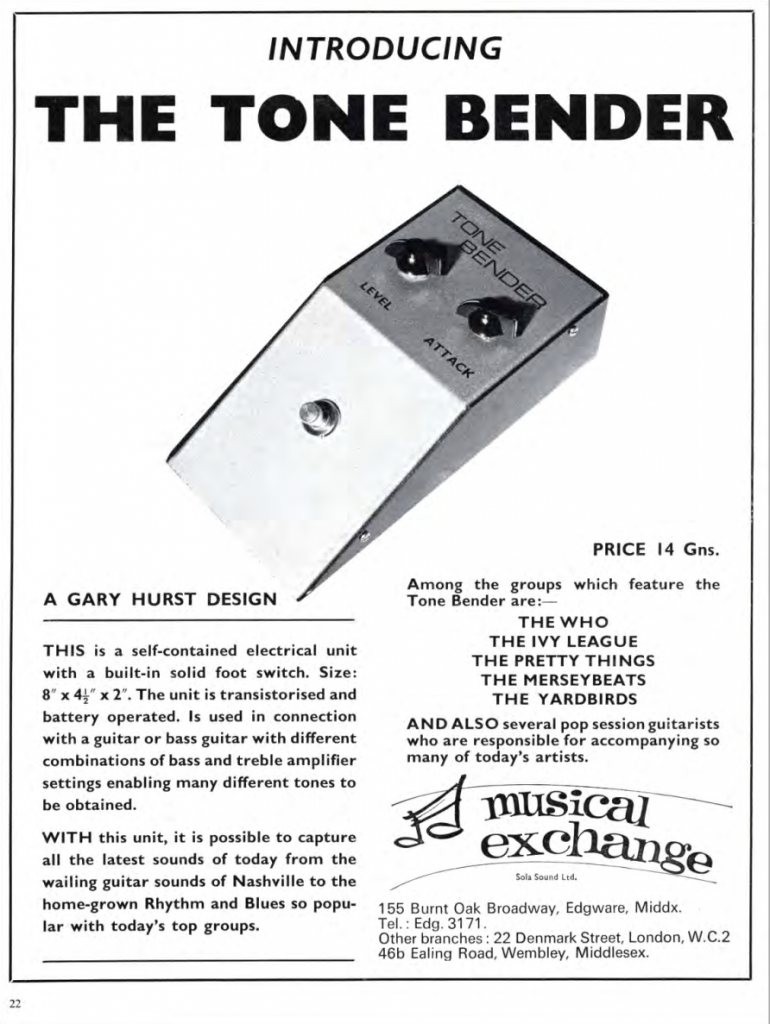
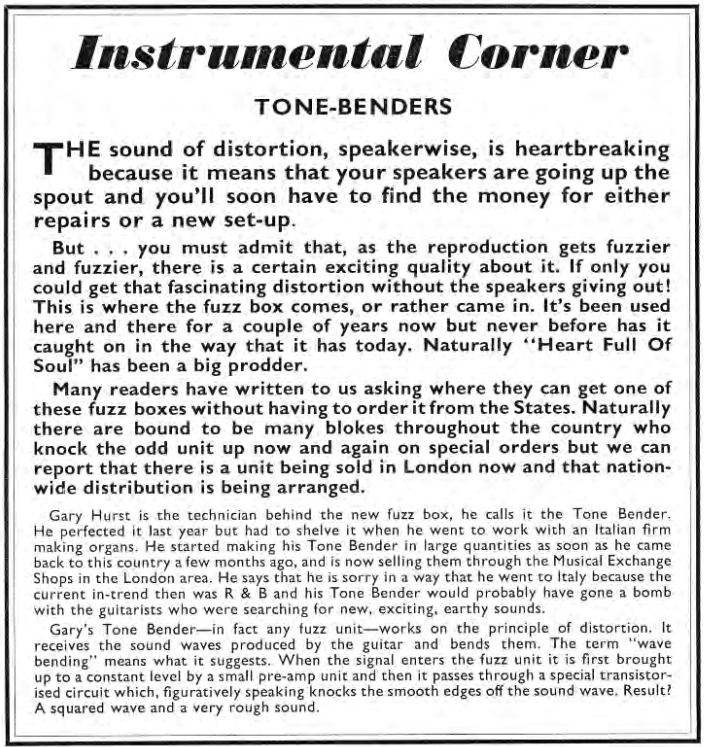
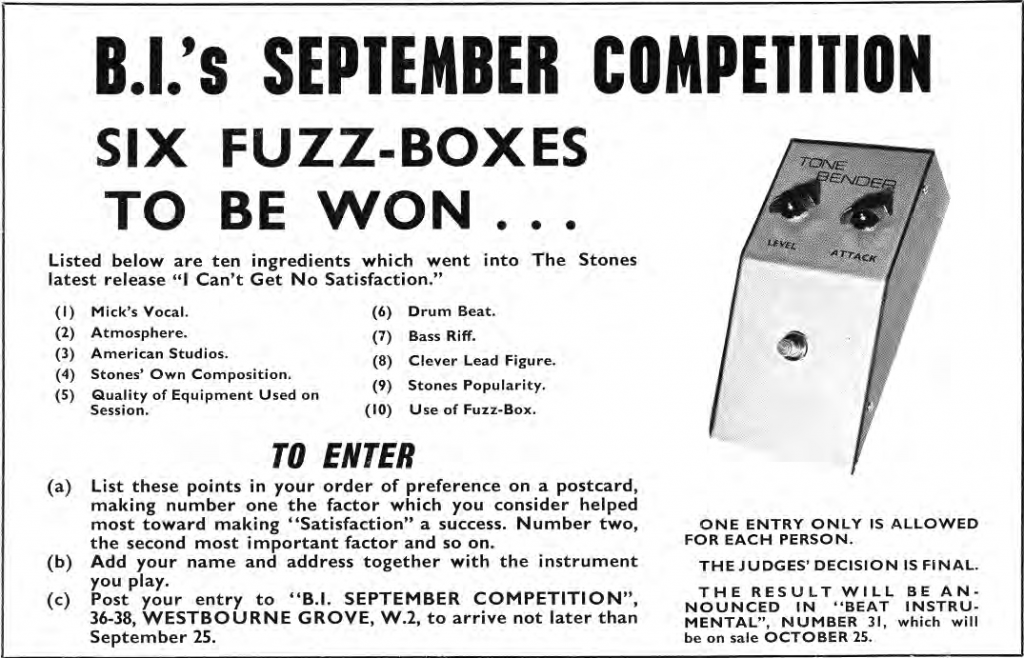
By the summer of 1965, Gary Hurst’s Tone Bender was already being marketed and promoted by Macari’s Musical Exchange. This is evidenced by the significant coverage that the ‘MKI’ received in the September 1965 issue of Beat Instrumental, including a full page advertisement for the model. Beat Instrumental also ran a promotional competition for the Tone Bender ‘MKI’ in the September 1965 issue. Of the six pedals that were given away, at least one is known to still survive, and it was recovered in recent years by the Macari family.
The Gary Hurst/Sola Sound Tone Bender ‘MKI’ continued to be advertised regularly in the Beat Instrumental & Melody Maker publications during 1965.
These early Tone Benders were first & foremost a Sola Sound product, marketed & sold by Macari’s Musical Exchange. Recently uncovered anecdotal evidence from original owners of Tone Bender ‘MKI’ fuzz boxes has, however, opened up the possibility that they may have also been supplied to other music shops for distribution beyond Denmark Street. Shops where early Tone Benders are reported to have been purchased include Selmer’s on Charing Cross Road11 12 and Jim Moore’s in Hornchurch, Essex.13 One ‘MKI’ user even reported acquiring their pedal from a shop as far away as in Newcastle.14
The Macari’s archive holds logbooks, detailing the payments made to Gary Hurst in exchange for his fuzz boxes, which reveal that production of the ‘MKI’ version continued at least into December of 1965. This model would, however, soon be replaced by one that was perhaps cheaper and easier to mass-produce.
Evolution of the ‘MKI’
Wooden Tone Benders
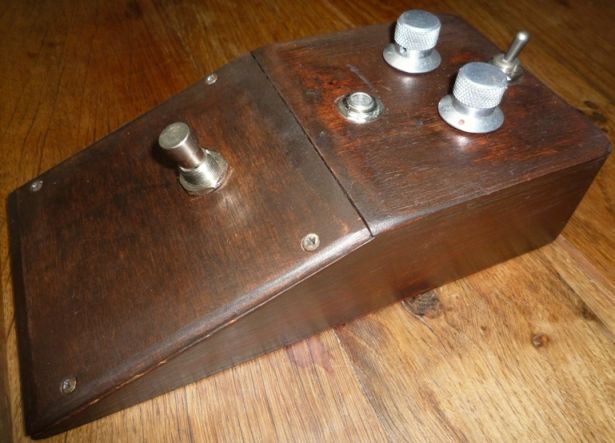
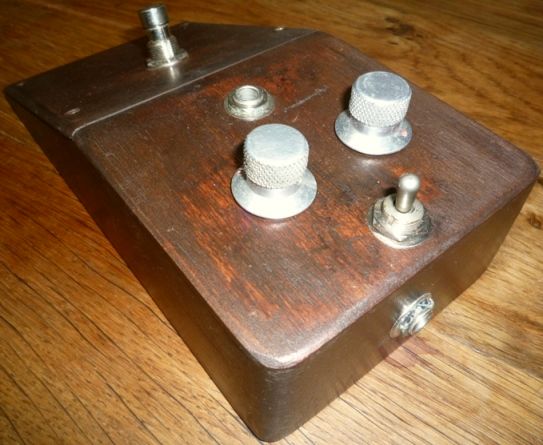
Gary Hurst’s earliest Tone Benders were built into wooden enclosures. By Gary’s own admission, he didn’t keep an exact count of how many of these wooden pedals were made. Gary estimated that he and his brother built 10 pedals a day, for a period of roughly 10 days, before the casing had to be redesigned to make it easier to meet the huge demand.15
Only a single wooden Tone Bender is known to have survived over the decades. This pedal, pictured above, remained in Gary Hurst’s possession for almost half a century, before being sold directly to a collector. The electronics inside this wooden Tone Bender were assembled on stripboard (also known as ‘Vero board’), and its circuitry boasts three black glass Mullard germanium transistors. (Photo credit: G. Green)
Hurst soon moved over to housing his Tone Benders into enclosures made of folded steel, presumably as part of an effort to scale up production. Hurst’s recollection of the wooden version of the Tone Bender having only been built for a very limited time is corroborated by a combination of the fact that Hurst only returned to London in April 1965, and that Jeff Beck was photographed already using the more sophisticated metal-bodied Tone Bender ‘MKI’ by the 4th of June 1965, during one of the Yardbirds’ appearances on ‘Ready Steady Go’.16
Early metal-bodied Tone Benders
Exhibit A
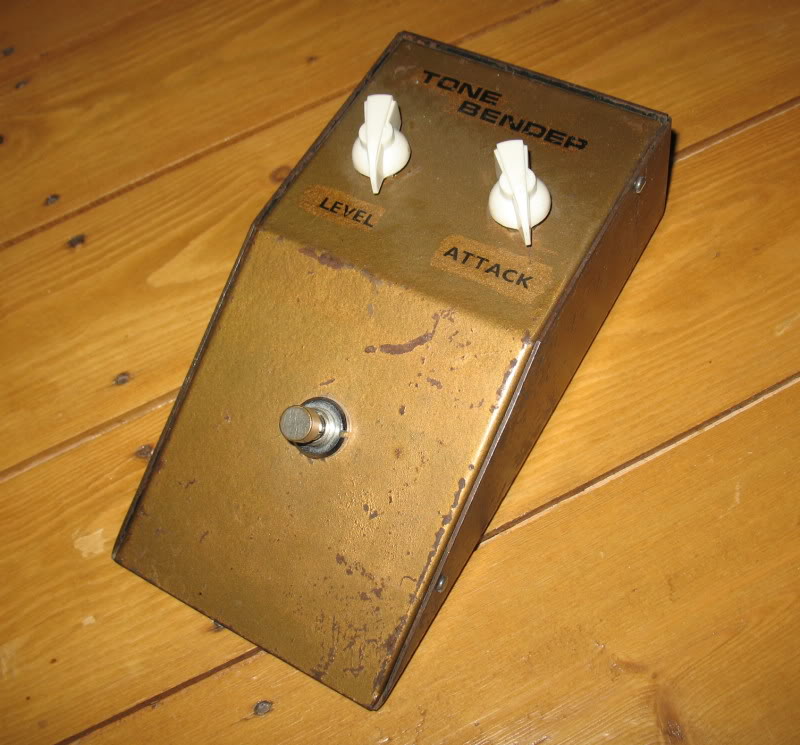
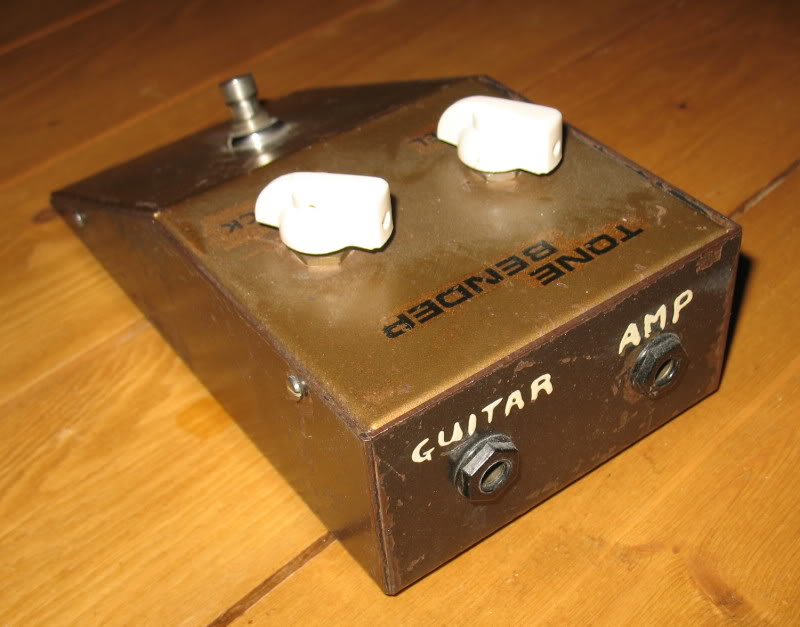
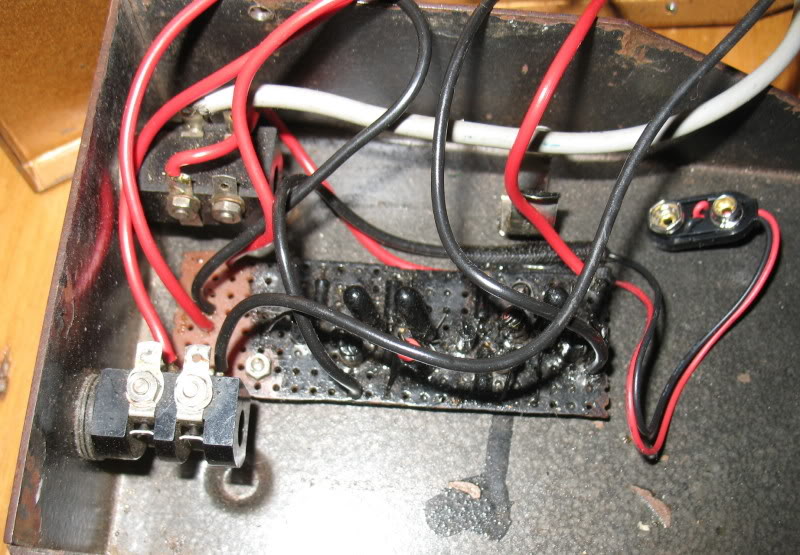
The enclosures of these metal-bodied Tone Bender ‘MKI’ pedals came with a distinctive gold-painted top half and a dark grey base. Earlier examples of these metal Tone Benders, like the one pictured above, were primitively decorated with Letraset lettering for the model name & the relevant labels for the controls & jack sockets. These Letraset graphics were applied by the then-girlfriend of Gary Hurst (who was also the niece of Larry & Joe Macari), and who also coated the lettering with clear lacquer to protect it from rubbing away.17
The Tone Bender above is unquestionably the earliest known surviving example of a metal-bodied Tone Bender ‘MKI’ thus far. It features Letraset lettering on the top half of the enclosure, as well as very crude hand-painted lettering denoting the jack sockets at the back. Electronically, this ‘MKI’ features the same stripboard construction as sighted in the single extant wooden Tone Bender, complete with three unknown black glass Mullard transistors. The circuit board in this Tone Bender has been painted over, in what is very likely to have been a deliberate attempt to discourage or frustrate attempts by others to copy the design. (Photo credit: S. Castledine)
Incidentally, the white knobs on this pedal were determined to be original after a photograph surfaced of Mick Ronson performing in London, in 1972, with a very similar looking Tone Bender.
Exhibit B
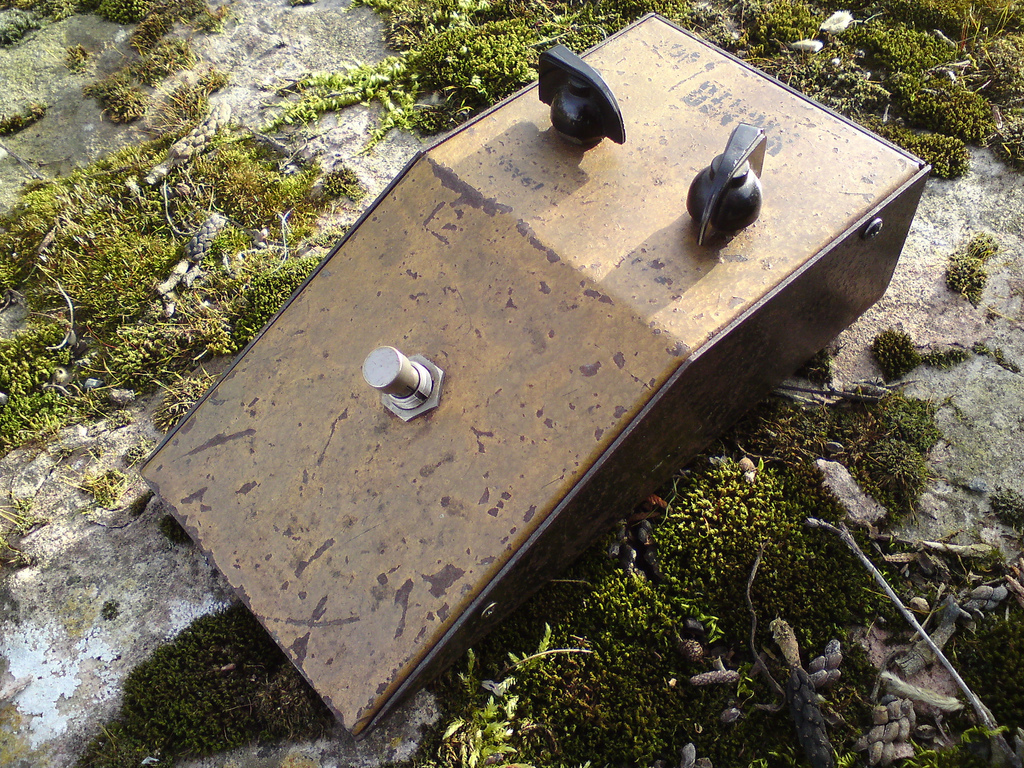
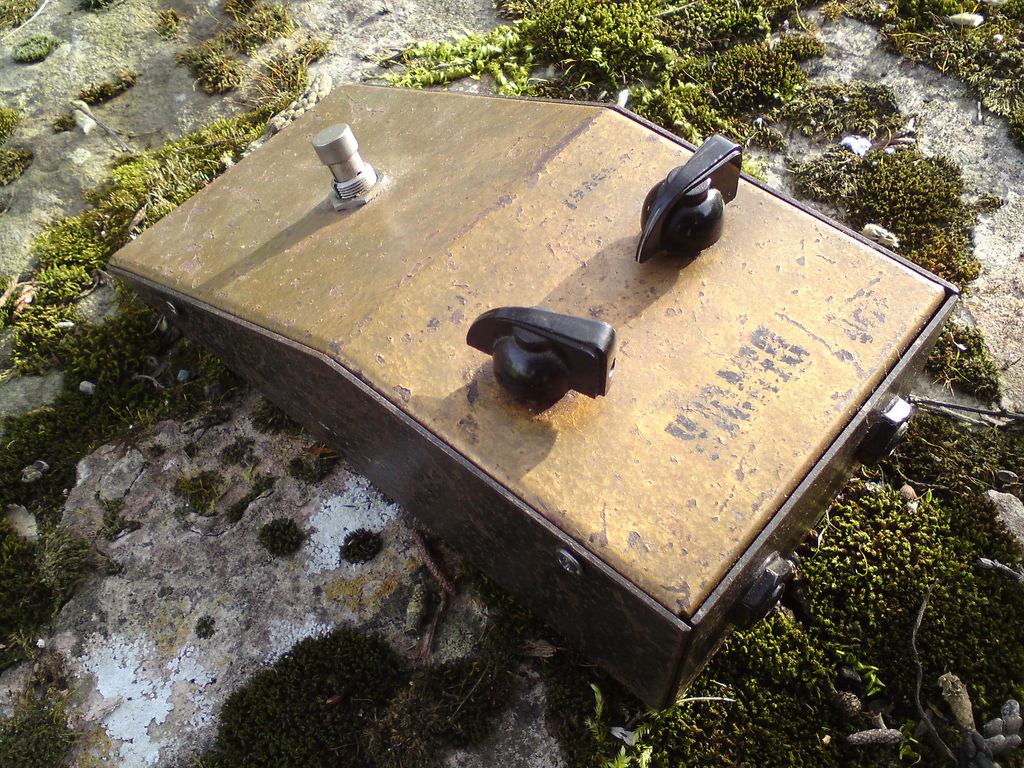
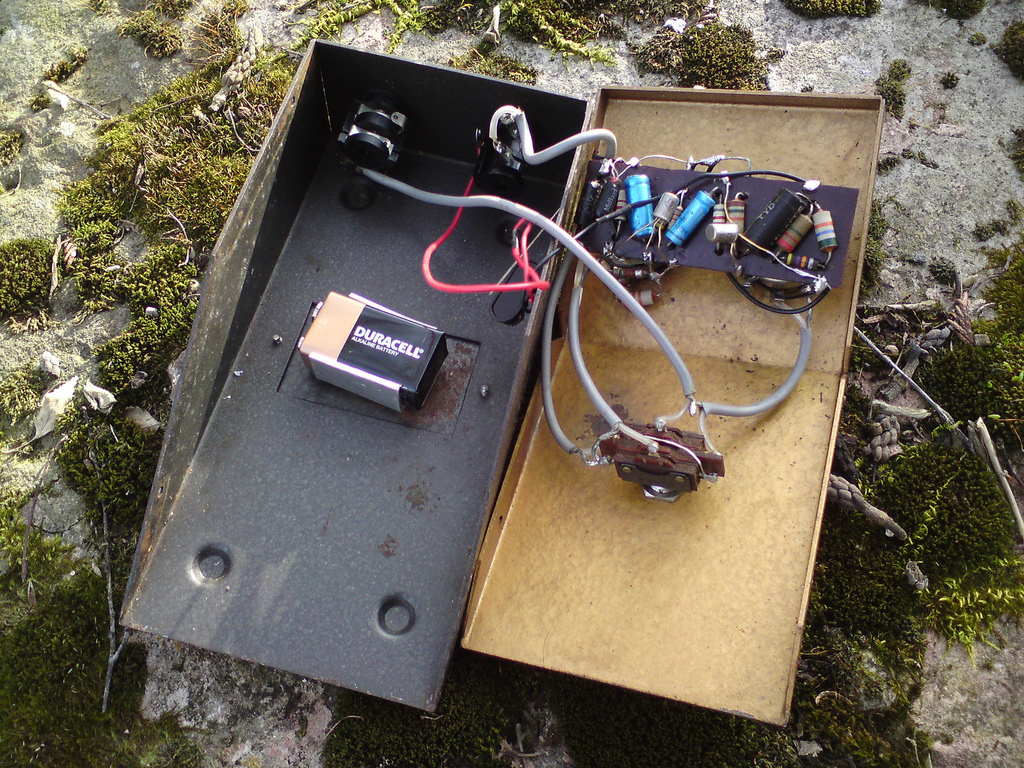
The Tone Bender ‘MKI’ pictured here is also a relatively early model, judging by the selection of parts and the remains of its Letraset lettering. By the time this Tone Bender was built, however, Gary Hurst was no longer putting the ‘MKI’ circuits together on stripboard. Instead, the Tone Bender was now built using a point-to-point parts layout, on its own dedicated board. The majority of surviving Tone Bender ‘MKI’ pedals were built using this construction style.
This particular pedal has been well-known to collectors for over two decades. At one point, it was part of Phil Harris’ Harris Hire backline, and it was pictured in Dave Hunter’s 2004 book, ‘Guitar Effects Pedals: The Practical Handbook’, albeit incorrectly captioned as an “Arbiter Tone Bender”. (Photo credit: L. Cook)
Exhibit C

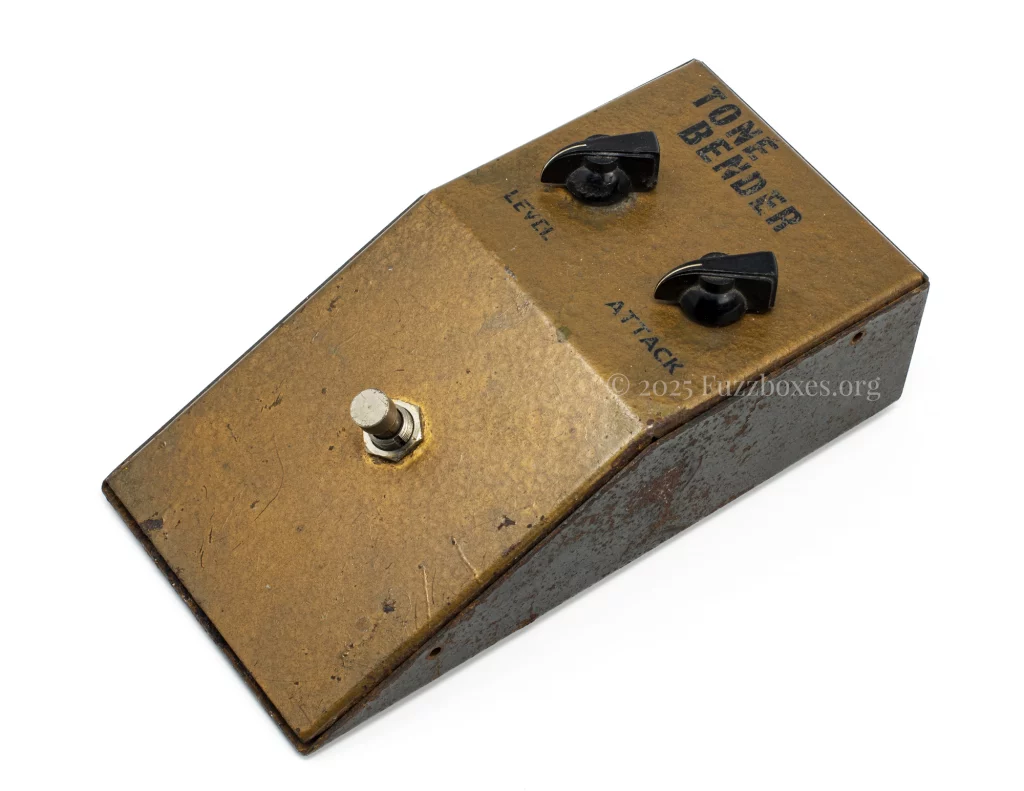
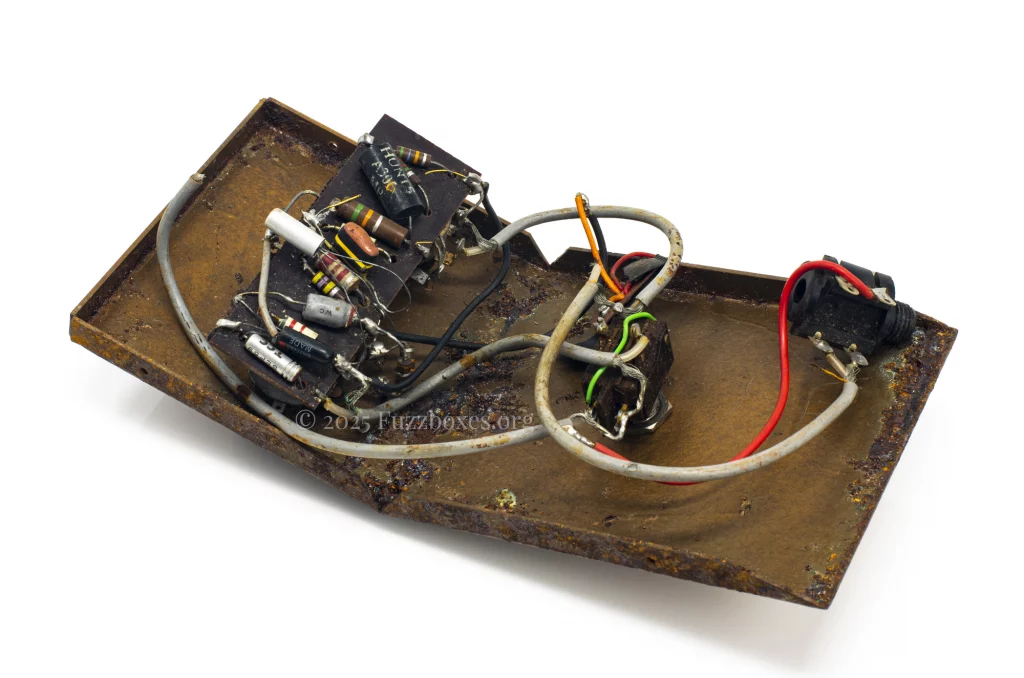
This Tone Bender is also an early ‘metal-bodied’ example. It shares a lot of similarities with the ‘ex-Harris Hire‘ unit pictured previously, but it’s notable for having a very unusual 4μF input capacitor and an Impex S3-1T transistor in the second position. These parts, along with the grey coupling capacitor on Q1’s emitter are the exact parts that were also used on some of the earliest Tone Bender ‘MK1.5’ pedals. It’s unclear whether this pedal started out with those unusual components, or whether it wound up back on Gary Hurst’s workbench very early on during its life to be reworked.
This unique ‘MKI’ originally belonged to famed luthier Bill Puplett, and was kindly sold to the Fuzzboxes.org project in 2025 by Bill’s family after he passed away.
Sola Sounds Limited
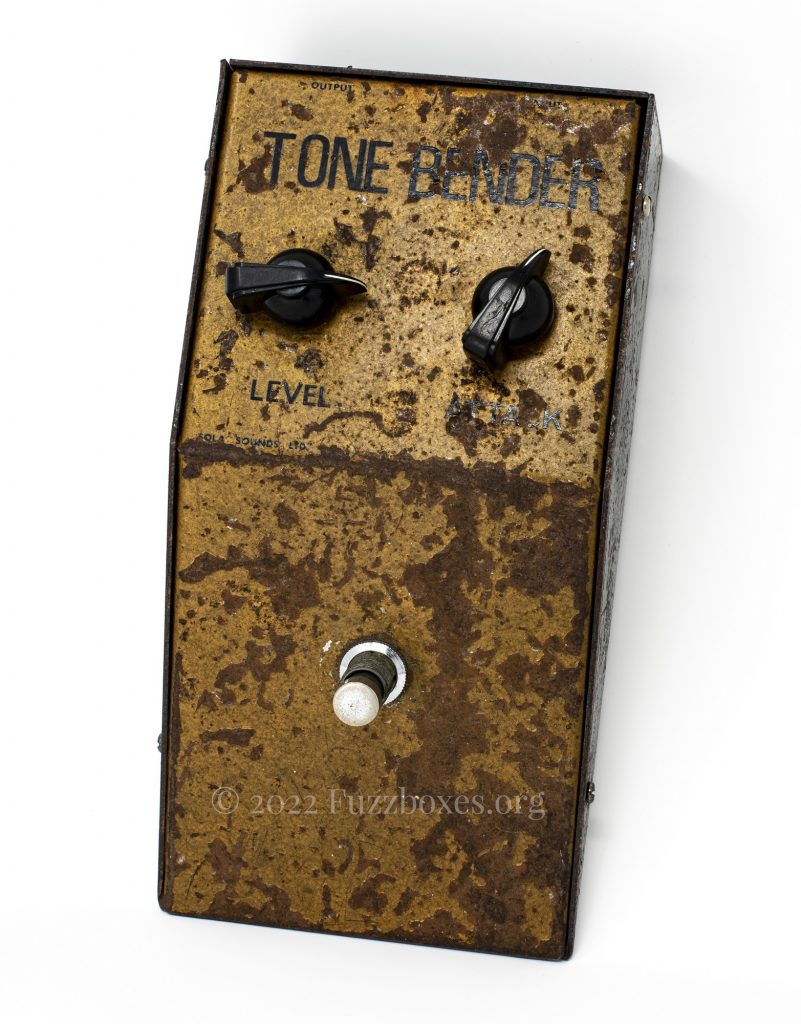
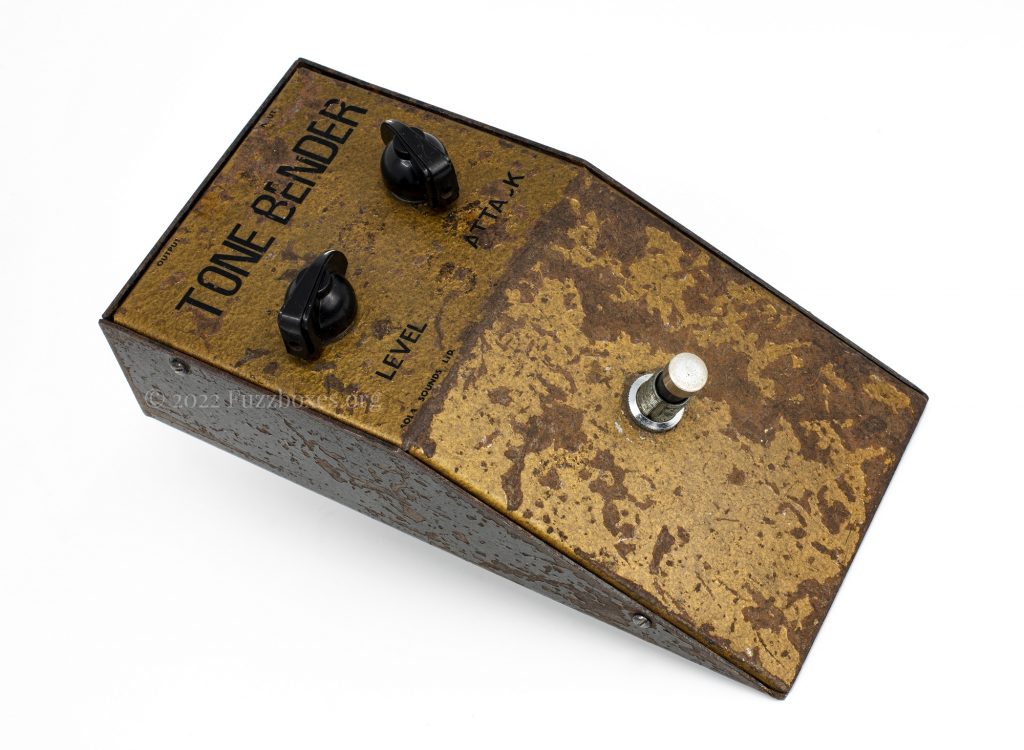
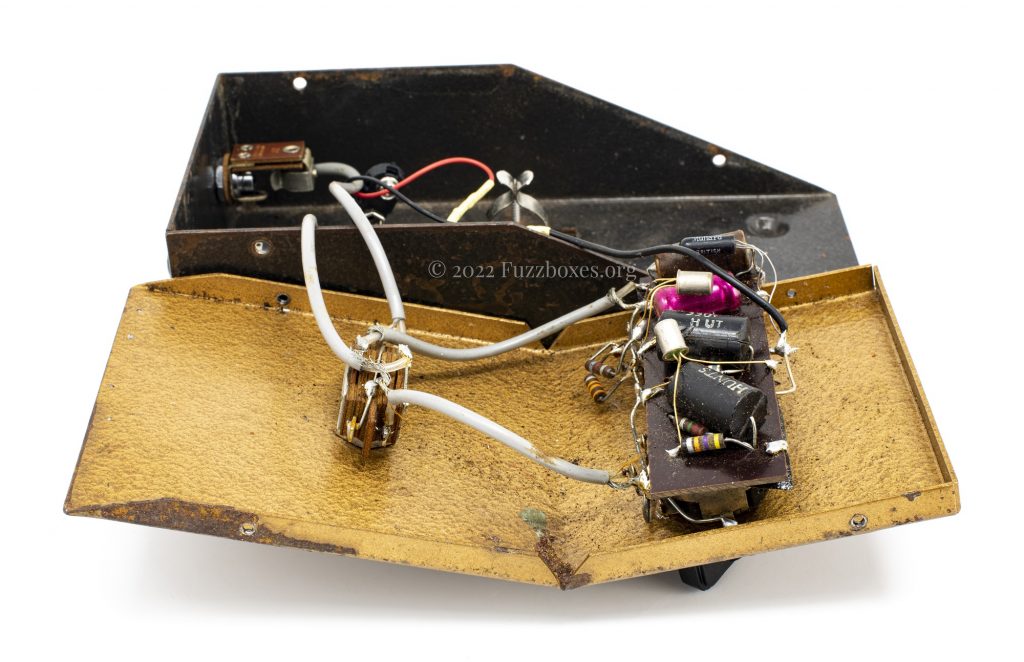
As development of the Tone Bender progressed, the ‘MKI’ started being marketed more professionally, and the practice of crude Letraset labels was replaced with a the printing of a cleaner set of silkscreened graphics. By this point, the ‘MKI’ also finally featured the Macaris’ Sola Sound brand name (in small print, below the ‘Level’ control). These features suggest that the Tone Bender pictured above is a relatively late-production example.
Despite the enclosure being in rather poor condition, this particular Tone Bender has miraculously retained all of its original parts inside. The battery connector was at some point, however, replaced, and the Bulgin ‘chicken head’ control knobs are also non-original (although they are consistent with the style of knobs that we would expect to see on a ‘MKI’ built at the time).
This particular pedal was sold in 2021 by musician & sound engineer Laurie “Lol” Beeching, who performed with it through the 1980s. Lol acquired the pedal from an enigmatic London-based guitarist known only as ‘Bonk’, who reputedly bought the pedal brand new in 1965, from Jim Moore’s music shop in Hornchurch, Essex.18
‘Bonk’ played in the 1960s with a group called the Diddley Daddies. I would be grateful to hear from anybody that has any further knowledge of ‘Bonk’ or the group(s) in which he played.
“Goldie”
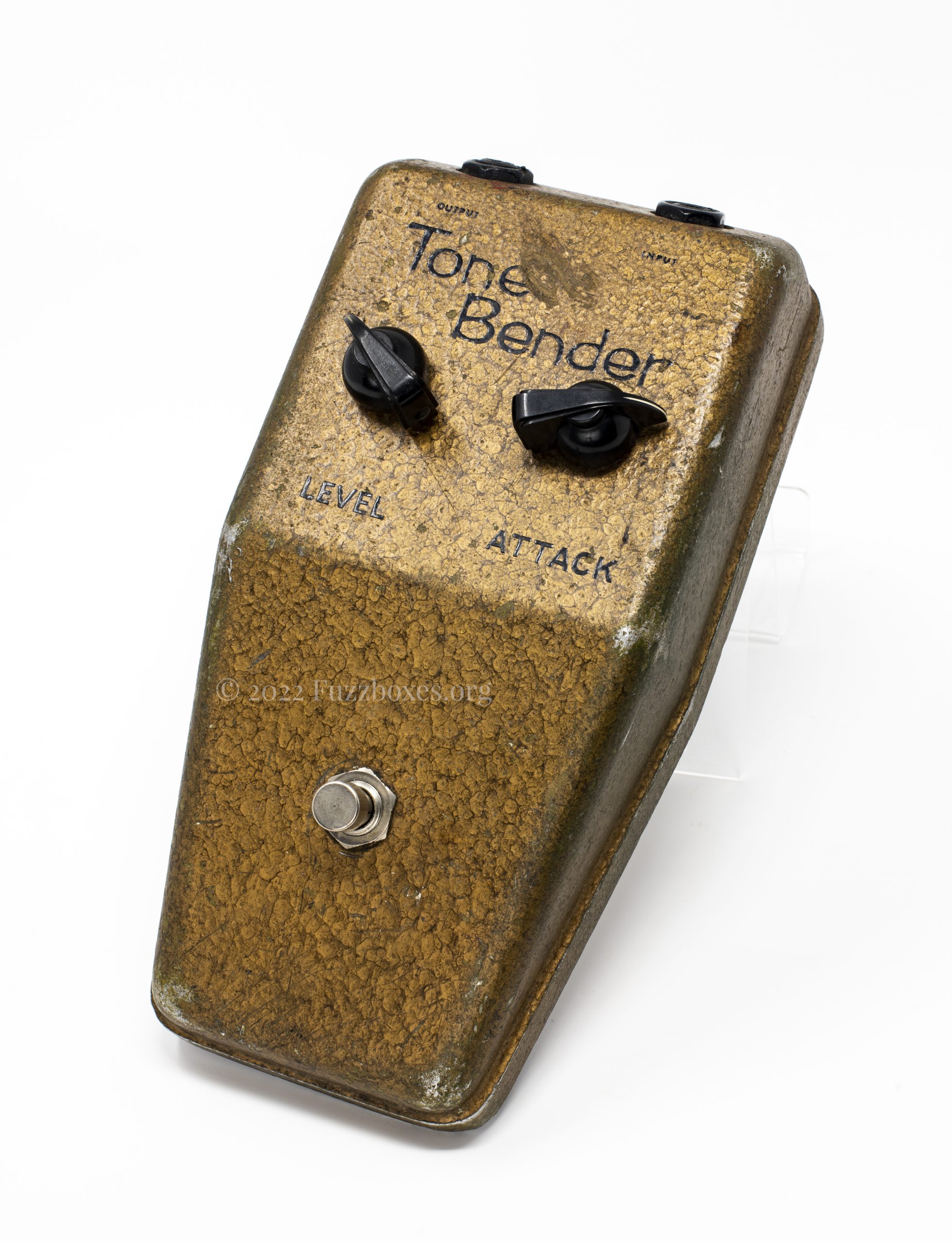
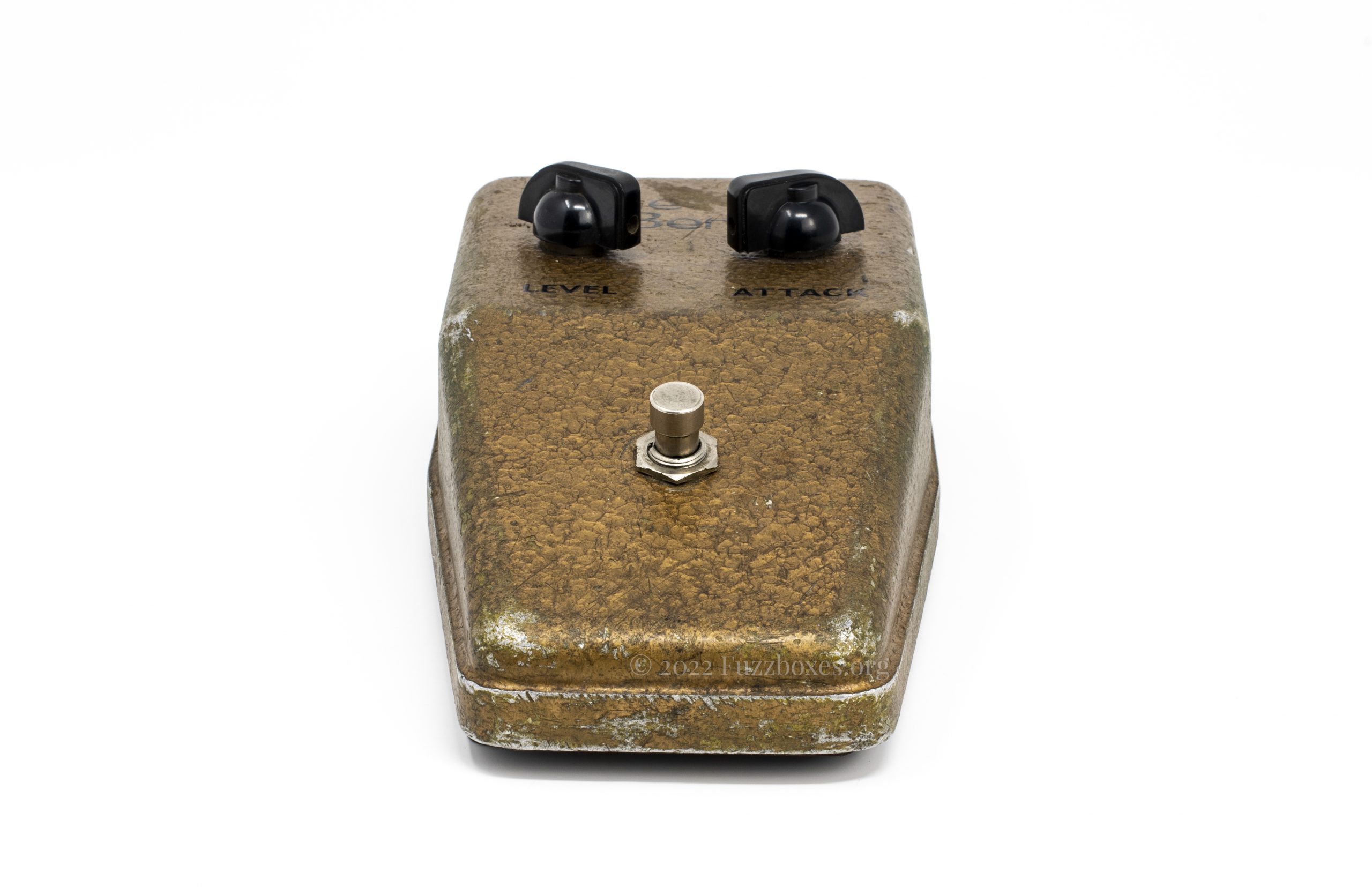
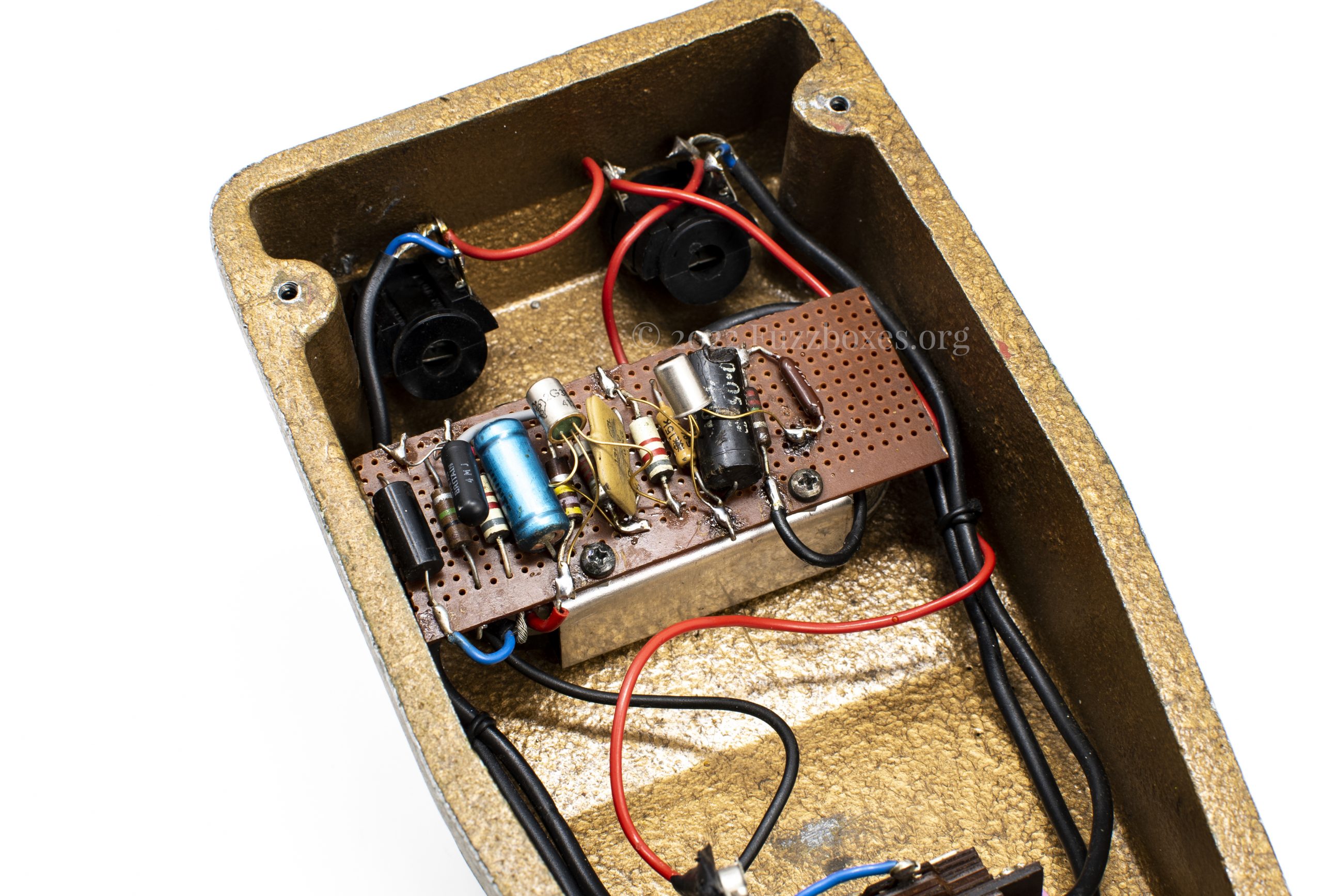
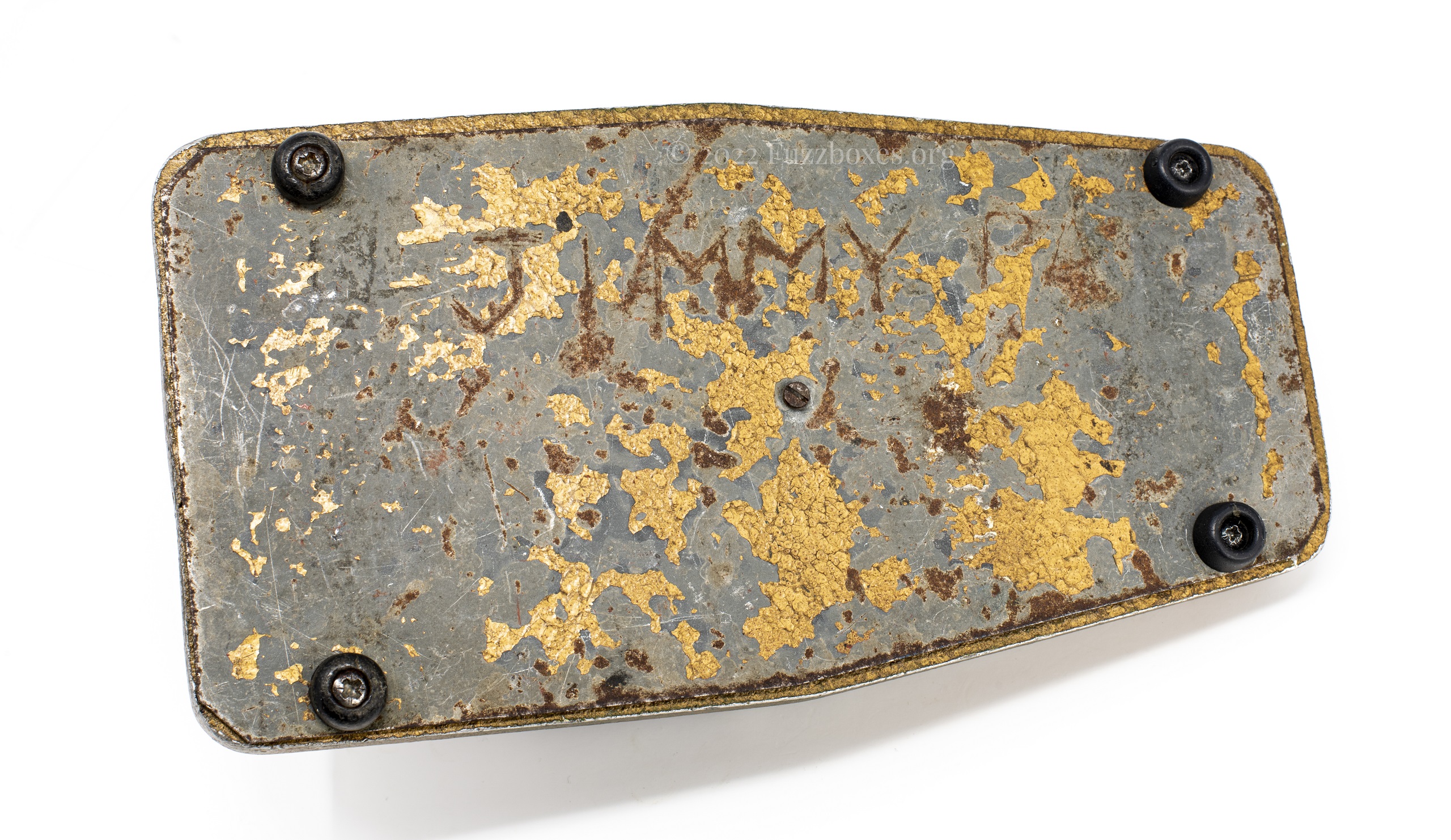
The Tone Bender ‘MKI’ pictured above is unusual in that it has been built into one of the earliest known examples of Sola Sound’s cast aluminium enclosure. The construction of the electronics is also unique (at the time of writing) in that the parts have been assembled on perforated circuit board, as opposed to on strip board, or point-to-point on a dedicated board.
Having been through various generations of repairs & restoration, it is uncertain whether the type of construction is original to the pedal, or indeed whether the electronics might originally have been housed in a conventional steel-bodied case and have been re-built to fit the cast model.
“Goldie” spent a significant portion of its life in Germany, with former owners including Hamburg-based producer (and musician) Jochen Petersen19 and session guitarist Frank Diez.20
Notable users
Despite having been in production for less than a year, Gary Hurst’s Tone Bender was hugely successful. This is evidenced by the lengthy roster of artists and groups who at one point or another were sighted using the model.
The Fuzzboxes.org blog ↵ has a comprehensive and up-to-date list of celebrity sightings, ranging from the Beatles & Beck, through to some more unusual and international acts.
Reader appeal
At the time of writing, I have yet to see two 1965 Tone Bender ‘MKI’ fuzz boxes that are exactly alike. Photos of further surviving pedals are incredibly useful when examining the development of this famous model, and I would be grateful for any readers’ submissions.
Photos, as well as general comments & queries about the 1965 Tone Bender can be sent via the form below, and also by contacting me directly.
Thanks to D. Main, S. Castledine, P. Johnston, J. Logan, & G. Green
- Beat Instrumental, January 1965, p. 25
- Guitarist, “Bend it like Beck can”, November 2009, p. 63
- Chitarre, “Fuzzmen”, December 2003, p. 68
- Guitarist, “Bend it like Beck can”, November 2009, p. 63
- Beat Instrumental, September 1965, p. 30
- Guitarist, “Bend it like Beck can”, November 2009, p. 63
- Chitarre, “Fuzzmen”, December 2003, p. 67
- Vic Flick, interviewed by David Main in 2003, and again by Kit Rae in 2013 (https://web.archive.org/web/20230129234225/https://stompboxes.co.uk/forum/viewtopic.php?f=6&t=1100&start=180)
- Vic Flick, interviewed by John Logan in 2009 and again in 2013
- Big Jim Sullivan, interviewed by John Logan in 2009 (https://web.archive.org/web/20230129220720/https://stompboxes.co.uk/forum/viewtopic.php?f=6&t=13401&p=274134)
- P. Miller (personal communication, 4th February 2012)
- Dave “Andy” Andrews, interviewed by Philip Johnston
- L. Beeching (personal communication, 1st July 2021)
- T. Graff (personal communication, 9th September 2018)
- Guitarist, “Bend it like Beck can”, November 2009, p. 63
- Tony Gale, June 1965, Yardbirds on Ready Steady Go [https://www.alamy.com/stock-photo-yardbirds-on-ready-steady-go-june-1965-from-l-chris-dreja-jim-mccarty-29460384.html]
- https://web.archive.org/web/20230131002637/https://stompboxes.co.uk/forum/viewtopic.php?p=138374
- L. Beeching (personal communication, 1st July 2021)
- F. Reinke (personal communication, 17th April 2016)
- F. Diez (personal communication, 1st September 2018)
